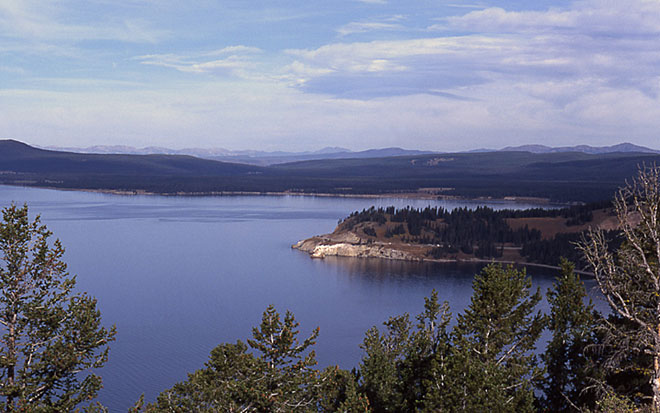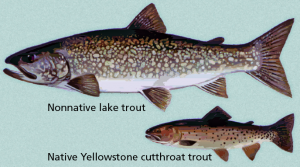What is the best ecological method for removal of lake trout in the Yellowstone National Park Lakes?

The largest body of water in the Yellowstone National Park, Yellowstone Lake, was once home to multiple fish species which brought great enjoyment to visiting anglers. However in the late 1980’s either by accident or intention the introduction of a non-native species, Lake Trout, began to damage native fish populations. Through predation and overcrowding the Lake Trout has decimated natives leaving only itself and the Cutthroat Trout in the lake. This shift in biodiversity has left the local ecosystem in chaos.

Lake trout are nearly double the size of the cutthroat species and are pisciviorous (meaning they eat other fish). This doesn’t seem like a major problem except that Lake Trout spend more time in deeper waters which puts additional pressure on Cutthroat from predators. In a way, the Cutthroat are being attacked and eaten from above and below. The decrease in Cutthroat has also made it harder for bears and osprey to get enough nutrients thus leading those species moving further from their typical habitat to find food.
When lake trout got introduced into the Yellowstone Lake, biologists knew that it was going to be a huge problem due to the fact that they’ve seen what Lake Trout have done to species in other lakes. Before the introduction of Lake Trout there were roughly 4 million Cutthroat Trout but after the infestation of Lake Trout that number steadily decreased to nearly 400,000 and the Lake Trout has just been increasing in numbers. Efforts such as gillnetting have shown to be the most promising way to get rid of the invasive fish. Gillnetting is when there are boats out in the lake with miles of net and they work all day trying to catch these fish deep down in the waters.
Approximately 1.7 million Lake Trout have been removed with gillnetting but the downside is they can be removing Cutthroat Trout as well with this process. In total with gillnetting, Yellowstone spends nearly $2 million a year to be able to keep this an ongoing thing and it will an ongoing event because it will be practically impossible to remove all Lake Trout. As time progresses new ways are being designed to help reduce the effects of Lake Trout. Techniques such as targeting Lake Trout eggs with electricity, to even using chemical toxins. So, we would like to ask you – what do you think is the best ecological method to remove Lake Trout from Yellowstone Lake?
Questions to be answered:
How did lake trout get into Yellowstone Lake?
Why is it a problem to have Lake Trout in Yellowstone Lake?
What role do Cutthroat Trout play in the Yellowstone ecosystem?
What methods are used to remove Lake Trout from Yellowstone?
What are the challenges of removing the Lake Trout?
Has the removal of Lake Trout been effective?
What steps must be take going forward to protect Cutthroat trout?
Extra links for viewing further information:
https://www.nps.gov/yell/learn/nature/Lake-Trout.htm
http://news.nationalgeographic.com/news/2013/1/130122-lake-trout-lake-yellowstone/
http://www.yellowstonepark.com/yellowstone-lake-cutthroat-trout-threatened-by-non-native-lake-trout/
#PackSixTroutFix
